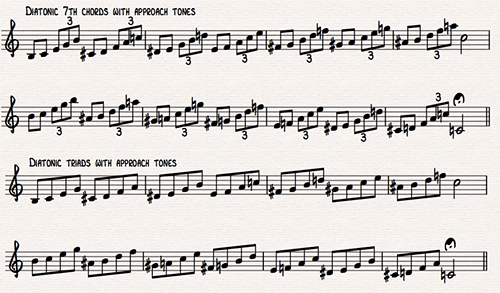Using Chromaticism to Elegantly Weave In and Out of Chord Changes

I used to struggle with chromaticism in my solos. I wanted nothing more than to achieve that bebop sound, weaving in and out of chord changes effortlessly and never repeating myself. It wasn’t until I consciously sat down and came up with some exercises geared specifically toward this concept that it started to come out in my playing.
I tend to think more vertically when improvising. I have always been drawn more towards visualizing chords than scales. So when I came up with these exercises I tried to play to my strengths and incorporate them with my work on diatonic chord structures.
If you haven’t worked on diatonic triads and seventh chords, that would be a good place to start. Many of you have, no doubt, already worked on this concept. Start with your diatonic triads played in triplets at a slow tempo getting your fingers and brain used to how these feel. I have written the exercise out in the key of C for you as the first exercise on the accompanying PDF. Make sure that you put the exercise in all 12 keys though. This is tough but absolutely necessary.

After getting these triads under your belt, we are going to add a chromatic approach tone to each triad. Now our triplet becomes a group of four eighth notes and allows us to use chromatic approach tones to add more interest to our lines.

You can also maintain the triplet feel by grouping the notes in a slightly different way, as you will see in the next exercise. My advice would be to practice both to develop as much rhythmic flexibility as possible. Remember, good solos are all about rhythm and as much harmonic knowledge you have under your belt doesn’t matter if you can’t phrase it properly.

The next set of exercises focus on adding chromaticism to diatonic seventh chords. Again, we start with learning the basic pattern of the purely diatonic chords. We are simply taking the same concept of the diatonic triads and adding the seventh to every chord.

The next exercise adds the lower chromatic approach tone just as in the triad workout but now we have a five-note phrase that needs a more creative rhythmic approach. The first rhythm we will utilize is two eight notes followed by a triplet.
 The next exercise reverses this rhythm, putting the triplet first and the eight notes following.
The next exercise reverses this rhythm, putting the triplet first and the eight notes following.

The last exercise explores the multitude of rhythmic approaches you can come up with to make this concept more flexible and useful. In this exercise we instead use sixteenth notes with a noted absence of triplets altogether.

These exercises will get you started on playing and hearing chromaticism injected into diatonic exercises. I suggest that you come up with 5-10 more exercises using the same concepts, but that are unique to your style of playing and the way you think about improvisation. In a future post, I will take this concept much further to other notes in the chords and more complicated thinking. For now though, concentrate on getting these exercises down in all 12 keys and at various tempos.
Good luck, start slow, and have fun!





